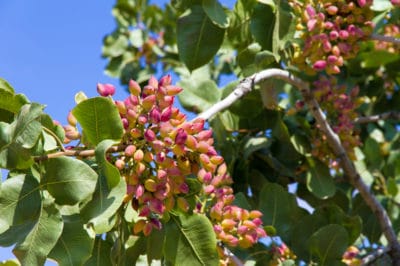Expert gardener’s tips:
- Don’t confuse pistachio trees grown for nuts (Pistacia vera) with Chinese pistache (Pistacia chinensis), a shade tree prized for spectacular red and orange fall color.
- Pistachio trees are male or female. Females won’t fruit without pollen from a compatible male but one male can pollinate up to 10 females.
USDA Hardiness Zones
Pistachios’ love for hot, dry summers makes them ideal for desert gardens and orchards, but only in USDA plant hardiness zones where:
- Winter temperatures are no colder than 5° F (12.2°C).
- They get 850 or more hours of temperatures between 34° and 45°F (1° and 7.2°C) in fall and winter. Otherwise, they won’t fruit.
- Spring is windy enough to pollinate them.
- Spring and summer rain or humidity is minimal. Both expose pistachios to a host of diseases.
These climate requirements limit pistachio growing to the driest parts of USDA zones 7b (a winter low of 5°F) through 10b (with winter lows between 35 and 40°F).
The Planting Site
Although pistachios accept infertile, rocky or even salty soil, they produce most heavily in deep, well-draining sandy loam. For the healthiest trees, aim for slightly alkaline soil with a pH in the 7.1 to 7.8 range. The best site also has little or no shade.
Planting Pistachios
Plant 1-year-old pistachio trees in January or February. Dig holes deep enough to contain their roots without bending. Allow 15 to 18 feet between individual trees and 20 to 22 feet between orchard rows. Water thoroughly after planting.
Expert gardener’s tip: Always plant compatible cultivars. Good pairings include female ‘Kerman’ with male ‘Peters’ pistachios and male ‘Randy’ with female ‘Golden Hills.’
Post-Planting Watering and Feeding
Water your trees infrequently and deeply. Insert a screwdriver 8 inches into the soil near the rootballs; if the soil is crumbly and dry, water with a soaker hose or garden hose set to a trickle. Stop in October when pistachios enter winter dormancy.
Feeding
To prevent mineral deficiency, treat the trees with a foliar spray containing zinc, boron and copper. Spray every three weeks for their first three years.
